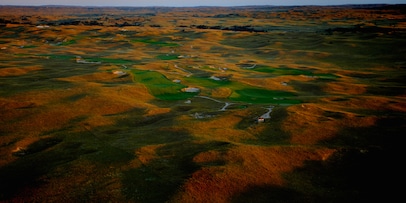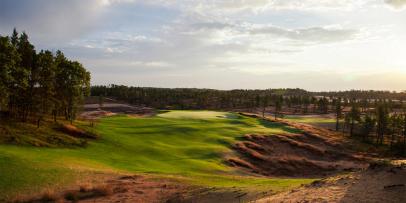Ben Crenshaw has never been a typical tour pro. Playing through an era defined by power and the likes of Jack Nicklaus, Johnny Miller, Tom Weiskopf, Greg Norman, Fred Couples and Davis Love III, Crenshaw stood out for his putter. He held a fascination with the history of the game, its past champions and the venues where they played that was as deep as it was atypical for professional athletes. And the courses he designed with partner Bill Coore have been broad and open with unconventional par values and enticing invitations to play the ball on the ground, a departure from the stringent aerial game, housing development designs that defined the tour player-architect genre of the past five decades.
Crenshaw joined with Coore in 1985. Even their partnership was out of the ordinary. Crenshaw had won his first Masters the year prior and was one of the most popular names in golf. Coore, to that point, had designed just one course on his own and was little known outside of east Texas where he’d been working as a designer and superintendent. While the personalities of the two men clicked, work was scarce the first few years until they landed their first major job designing the Plantation Course at Kapalua in 1990, building it with a team of shapers—including Dave Axland and Dan Proctor—who would continue to run Coore-Crenshaw jobs for decades.
Their breakthrough was Sand Hills Golf Club, opened in 1995, where developer Dick Youngscap entrusted Crenshaw and Coore, with all of two golf courses on their resume (including the Coore-Crenshaw course at Omni Barton Creek), to some 8,000 acres of rolling, wide open sand dunes in central Nebraska, some of the most ideally suited land for golf to be built on in the U.S. in nearly 60 years.
There they found a spellbinding combination of holes laying in the contours of the large, grassy dunes and moved almost no earth to formalize them other than to notch greens and excavate blowout bunkers. Sand Hills was a turning point in architecture: It ushered in an age of minimalism and naturalism, and demonstrated that players would eagerly travel to remote locations for unique, inspiring golf experiences. It also proved vast sums of money weren’t necessary to build world-class golf as long as the site has certain links-like qualities.
 Private Sand Hills Golf Club Mullen, NE 4.9 174 Panelists
Private Sand Hills Golf Club Mullen, NE 4.9 174 Panelists
- 100 Greatest
- Best In State
The golf course wasn’t so much designed as discovered. Bill Coore and Ben Crenshaw trudged back and forth over a thousand acres of rolling sand hills in central Nebraska, flagging out naturally-occurring fairways and greens. By moving just 4,000 cubic yards of earth, and letting the winds shape the bunkers, the duo created what is undoubtedly the most natural golf course in America, a timeless course design. For decades, winter winds had always reshaped the bunkers, but course officials have recently discovered a method to prevent that. At the close of the season, they spray the surface of the sand in bunkers with a product that creates a crust to resist the howling winds. Explore our full review
Sand Hills, now ranked eighth on Golf Digest America’s 100 Greatest Courses, launched Crenshaw and Coore toward a string of remarkable courses in remarkable golf-ideal settings, including Bandon Trails, Old Sandwich and Friar’s Head, each among Golf Digest’s top 100 courses, as well, among others Cabot Cliffs, Streamsong’s Red Course, Trinity Forest, Sand Valley and Sheep Ranch.
At each site they continue to honor the existing land and resist manufacturing features where it isn’t necessary, though at projects like the recently opened Point Hardy at Cabot Saint Lucia and “The Back Yard” at McArthur in Florida they’ve shown a capability to engineer golf onto challenging properties. Crenshaw and Coore have three courses currently under construction and expect to begin building their course at Rodeo Dunes in Colorado this spring.
If it’s possible to have an architectural career that matches a Hall of Fame playing record that includes 19 PGA Tour wins, two Masters titles and the captaincy of the winning 1999 U.S. Ryder Cup team, Crenshaw has done it.
Ben Crenshaw joins architecture editor Derek Duncan and golf course builder Jim Urbina on the Feed the Ball Salon podcast to discuss the enduring friendship and design symbiosis he’s has with Bill Coore, where his enthusiasm for golf courses and course design came from, the connection between playing in Texas and his love of the ground game, the types of greens he most admires and his memories of working in the Sand Hills.
More From Golf Digest  Courses The best Coore and Crenshaw golf courses
Courses The best Coore and Crenshaw golf courses
Listen below, or at Apple podcasts or Spotify.
Listen to the conversation below:
This article was originally published on golfdigest.com
